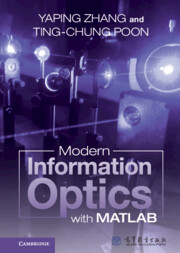Book contents
- Frontmatter
- Dedication
- Contents
- Preface
- 1 Gaussian Optics and Uncertainty Principle
- 2 Linear Invariant Systems and Fourier Analysis
- 3 Wave Propagation and Wave Optics
- 4 Spatial Coherent and Incoherent Optical Systems
- 5 Principles of Coherent Holography
- 6 Digital Holography
- 7 Spatial Light Modulators for Processing Optical Information
- Index
- References
1 - Gaussian Optics and Uncertainty Principle
Published online by Cambridge University Press: 22 December 2022
- Frontmatter
- Dedication
- Contents
- Preface
- 1 Gaussian Optics and Uncertainty Principle
- 2 Linear Invariant Systems and Fourier Analysis
- 3 Wave Propagation and Wave Optics
- 4 Spatial Coherent and Incoherent Optical Systems
- 5 Principles of Coherent Holography
- 6 Digital Holography
- 7 Spatial Light Modulators for Processing Optical Information
- Index
- References
Summary
This chapter contains Gaussian optics and employs a matrix formalism to describe optical image formation through light rays. In optics, a ray is an idealized model of light. However, in a subsequent chapter, we will also see a matrix formalism can also be used to describe, for example, a Gaussian laser beam under diffraction through the wave optics approach. The advantage of the matrix formalism is that any ray can be tracked during its propagation though the optical system by successive matrix multiplications, which can be easily programmed on a computer. This is a powerful technique and is widely used in the design of optical element. In this chapter, some of the important concepts in resolution, depth of focus, and depth of field are also considered based on the ray approach.
Keywords
- Type
- Chapter
- Information
- Modern Information Optics with MATLAB , pp. 1 - 20Publisher: Cambridge University PressPrint publication year: 2023



